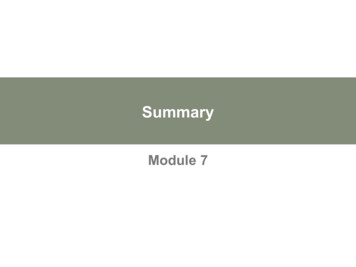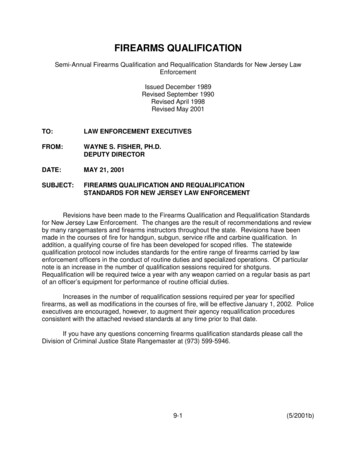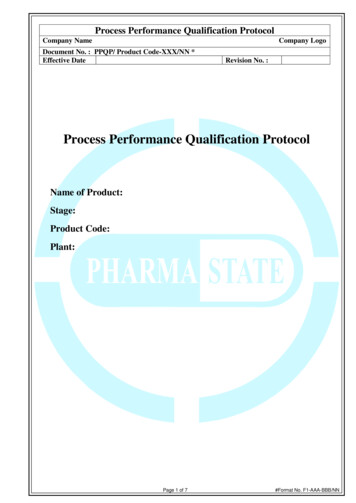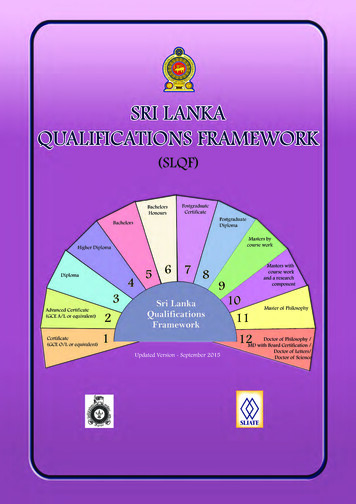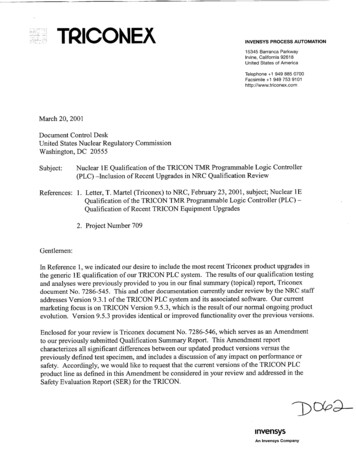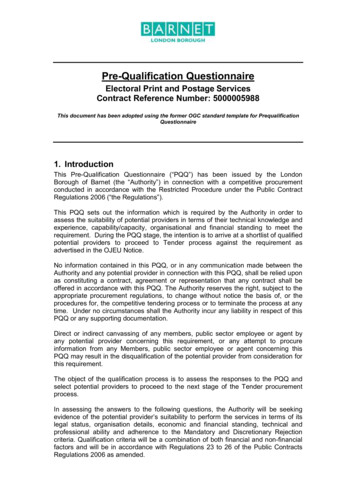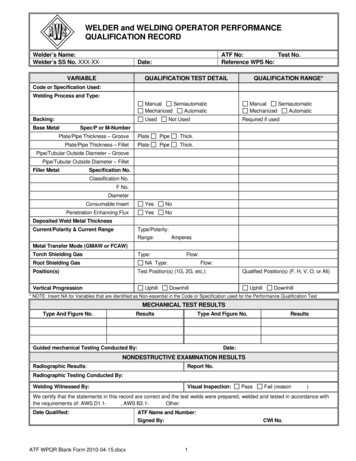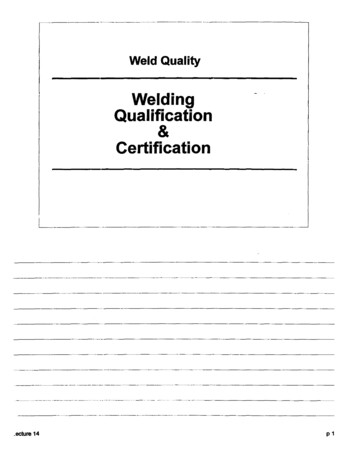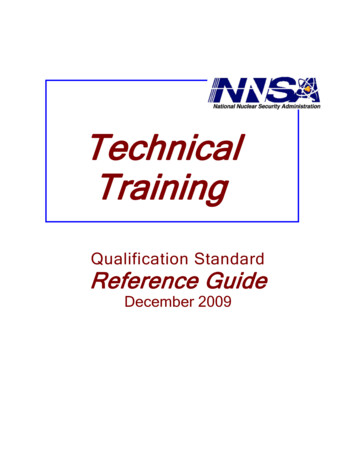
Transcription
TechnicalTrainingQualification StandardReference GuideDecember 2009
This page is intentionally blank.
Table of ContentsLIST OF FIGURES . iiLIST OF TABLES . iiACRONYMS . iiiPURPOSE. 1SCOPE . 1PREFACE. 1TECHNICAL COMPETENCIES. 31. Technical training personnel shall demonstrate an expert level of knowledge and abilityto implement the systematic approach to training model. This includes the ability to:. 32. Technical training personnel shall demonstrate a working level knowledge of DOEtraining organizations, strategic initiatives, roles and responsibilities, and trainingadministration and infrastructure. . 63. Technical training personnel shall demonstrate the ability to plan, conduct, anddocument a training needs assessment or job analysis of a position to determine thetraining requirements associated with that position. 184. Technical training personnel shall demonstrate a working-level knowledge of trainingcourse and/or program design techniques and methodologies. . 235. Technical training personnel shall demonstrate a working-level knowledge of the process,techniques, and methodology associated with training material development. . 316. Technical training personnel shall demonstrate a working-level knowledge of adultlearning methodologies, instructional media and methods, and instructor techniques requiredto conduct a training session or evaluate the effectiveness of training sessions. 367. Technical training personnel shall demonstrate a working-level knowledge of OJTtechniques, methodology, and implementation and apply that knowledge to implementand/or evaluate OJT programs in the field. 438. Technical training personnel shall demonstrate a working-level knowledge of oral,written, and performance evaluation techniques and methodologies, and other techniquesused to evaluate the effectiveness of a training program. 609. Technical training personnel shall demonstrate a working-level knowledge of therequirements and attributes associated with an effective records management system. . 6610. Technical training personnel shall demonstrate the ability to plan, conduct, anddocument an overall evaluation of a technical training and qualification program oractivity, and report those results to management in a concise and effective manner. . 7311. Technical training personnel shall demonstrate a working-level knowledge of theprinciples and functions of the Integrated Safety Management System (ISMS) and howintegrated safety management (ISM) contributes to personnel competence. . 7512. Technical training personnel shall demonstrate a working-level knowledge of DOE O360.1B, Federal Employee Training, DOE M 360.1-1B, Federal Employee TrainingManual, and DOE M 426.1-1, Federal Technical Capability Manual, sufficient to ensurethat training programs for federal personnel are accomplished in accordance with therequirements of the Order. . 7713. Technical training personnel shall demonstrate a working level knowledge of the contentand applicability of the DOE resources and guidance documents related to theimplementation of DOE federal and contractor training programs. . 82i
Table of Contents14. Technical training personnel shall demonstrate a working-level knowledge of therequirements of applicable DOE Orders and rules to determine if a contractor at afacility is implementing effective training and qualification programs. 8315. Technical training personnel shall demonstrate a working-level knowledge of basicassessment principles and processes associated with evaluating DOE contractors such asoperational readiness reviews (ORRs), readiness assessments (RAs), and businessmanagement oversight reviews. This includes the planning and use of observations,interviews, and document reviews to assess compliance with established criteria orrequirements. 9016. Technical training personnel shall demonstrate a working-level knowledge of contractsand procurement processes and procedures, and how they apply to procurement oftraining-related services or products. 9517. Technical training personnel shall demonstrate a familiarity-level of knowledge ofproject management practices sufficient to manage training-related programs andprojects. 101Selected Bibliography and Suggested Reading . 114FiguresFigure 1. Using the ADDIE Model.3Figure 2. Criteria for selecting tasks for training .20Figure 3. Task list-based OJT checklist .45Figure 4. Combination task list/TES OJT checklist.45Figure 5. OJT guide .55Figure 6. Task oriented network .111Figure 7. Event oriented network.113TablesTable 1. Difficult behaviors and possible responses .37Table 2. Task and precedence relationships.110Table 3. Linear program.112Table 4. Linear program.112ii
PRFPSAESATSMETESWBSanalyze, design, develop, implement, and evaluateAmerican Nuclear SocietyAmerican National Standards InstituteAmerican Society for Training and Developmentcritical decisionChief Financial Officercritical-path methodDepartment of Energy Acquisition Regulationdifficulty, importance, and frequencyU.S. Department of EnergyFederal Acquisition Regulationfunctional area qualification standardFederal Technical Capability Programgeneral employee trainingHuman Capital ManagementHeadquartershuman resourceindependent cost estimateintegrated safety managementintegrated safety management systemkey decisionknowledge, skill, and abilitymanagement and operatingNational Environmental Protection AgencyNational Nuclear Security Administrationon-the-job trainingOccupational Safety and Health Administrationquality assurancequality assurance programrequest for proposalSecretarial Acquisition Executivesystematic approach to trainingsubject matter experttraining/evaluation standardwork breakdown structureiii
PURPOSEThe purpose of this reference guide is to provide a document that contains the informationrequired for a Department of Energy (DOE)/National Nuclear Security Administration (NNSA)technical employee to successfully complete the Technical Training Functional AreaQualification Standard (FAQS). Information essential to meeting the qualification requirementsis provided; however, some competency statements require extensive knowledge or skilldevelopment. Reproducing all the required information for those statements in this document isnot practical. In those instances, references are included to guide the candidate to additionalresources.SCOPEThis reference guide addresses the competency statements in the February 2004 edition ofDOE-STD-1179-2004, Technical Training Functional Area Qualification Standard. Thequalification standard contains 17 competency statements.Please direct your questions or comments related to this document to the NNSA Learning andCareer Development Department.PREFACECompetency statements and supporting knowledge and/or skill statements from the qualificationstandard are shown in contrasting bold type, while the corresponding information associated witheach statement is provided below it.A comprehensive list of acronyms and abbreviations is found at the beginning of this document.It is recommended that the candidate review the list prior to proceeding with the competencies,as the acronyms and abbreviations may not be further defined within the text unless specialemphasis is required.The competencies and supporting knowledge, skill, and ability (KSA) statements are takendirectly from the FAQS. Most corrections to spelling, punctuation, and grammar have been madewithout remark, and all document-related titles, which variously appear in roman or italic type orset within quotation marks, have been changed to plain text, also mostly without remark.Capitalized terms are found as such in the qualification standard and remain so in this referenceguide. When they are needed for clarification, explanations are enclosed in brackets.Every effort has been made to provide the most current information and references available asof December 2009. However, the candidate is advised to verify the applicability of theinformation provided. It is recognized that some personnel may oversee facilities that utilizepredecessor documents to those identified. In those cases, such documents should be included inlocal qualification standards via the Technical Qualification Program.In the cases where information about an FAQS topic in a competency or KSA statement is notavailable in the newest edition of a standard (consensus or industry), an older version isreferenced. These references are noted in the text and in the bibliography.1
Only significant corrections to errors in the technical content of the discussion text sourcematerial are identified. Editorial changes that do not affect the technical content (e.g.,grammatical or spelling corrections, and changes to style) appear without remark.2
TECHNICAL COMPETENCIES1. Technical training personnel shall demonstrate an expert level of knowledge andability to implement the systematic approach to training model. This includes theability to: Conduct a job or task analysis or needs assessment, analyze the data, andprovide recommendations based on results; Design a training course or program to satisfy training requirements; Develop a training course and supporting materials; Implement a training course or program; and Evaluate a training course or program as part of the systematic approach totraining process or to assess return on investment.a. State the five steps of the SAT process and produce a basic sketch showing therelationship between the steps.The following is taken from Instructional Design: Using the ADDIE Model.The acronym ADDIE stands for analyze, design, develop, implement, and evaluate. It is asystematic approach to training (SAT) model that has withstood the test of time and use. It issimply a device to help us think through a course’s design. Though the model appears linear,it does not have to be followed rigidly or in a linear approach, especially if you already havecourse materials developed. The table below gives an abbreviated overview of some of thecomponents of nning;thinking about thecourseDesign your course onpaperDevelop coursematerials andassemble the courseBegin teachingLook at the courseoutcomes with acritical eye Design of courseAudienceGoalObjectivesIdentify contentIdentifyenvironment giesFormativeEvaluation Name the learningunits ofinstructionIdentify contentand strategies foran individual unitof instructionWrite instructionsfor the learningunitName the menuitems for alearning module Based ondesign phaseBuild content,assignments,assessmentsBuild coursestructureUploadcontent Overview ofcourseExpectationsInitiate instructionInteractionAsk for feedbackearly on (formativeevaluation)ConstraintsSource: Instructional Design: Using the ADDIE ModelFigure 1. Using the ADDIE Model3 Did thestudentsachieveexpectedlearningoutcomes?What haveyou learned?How can youmake thecourse better?
b. Referring to DOE-HDBK-1078-94, Training Program Handbook: A SystematicApproach to Training, describe in detail the activities that occur in each of the fivesteps of the SAT process, and list the products that may result from each of thesteps.The following is taken from DOE-HDBK-1078-94.AnalysisThis section addresses three methods of identifying training/performance requirements:needs analysis, job analysis, and task analysis. The major outputs of the analysis phases are atask list for each position, and a task-to-training matrix.The task-to-training matrix identifies the training disposition of the tasks identified in thetask list and lists the existing materials that support task performance. Participation of subjectmatter experts (SMEs) and facility personnel is emphasized throughout the processes.DesignThe design phase uses the information collected during the analysis phase to provide a“blueprint” for developing training programs based on the SAT model. This step in theprocess addresses methods for writing learning objectives, setting training standards,designing tests, and preparing training plans. The major outputs of the design phase arelearning objectives and test items. For existing programs, contractors are encouraged todetermine if their learning objectives are appropriate, cover all required content, and includeappropriate criteria and conditions.DevelopmentDevelopment incorporates the results of the design activities. The major outputs of thedevelopment phase are the completed lesson plans and training aids.ImplementationImplementation encompasses taking the results of the development phase into the trainingsetting and conducting the training. The major output of the implementation phase is trainedpersonnel.EvaluationEvaluation consists of a periodic review of the training materials and methods of solicitingfeedback from former trainees and their supervisors on the effectiveness of training. Themajor outputs of evaluation are the decisions made to improve the training program duringall phases.c. Describe the purpose and process for conducting a needs analysis, job analysis,and task analysis.The following descriptions are taken from DOE-HDBK-1078-94.Needs AnalysisA needs analysis can identify solutions to job performance discrepancies. Substandardperformance may be related to faulty equipment, inadequate procedures, attitude of the4
workforce, etc. Prior to developing new courses or modifying existing training programs, aneeds analysis should be conducted to determine that training is the appropriate solution.Job AnalysisA job analysis is conducted to develop a detailed list of duty areas and tasks for a specific jobor position. It can also supply information to develop a job/position description, if desired.Job analyses also allow comparison of existing training programs to established requirementsand identify deficiencies in the adequacy of program content. For existing programs, the jobanalysis provides reasonable assurance that all tasks essential to safe and efficient operationare addressed by the training program. It also identifies parts of the training program that areunnecessary, thus resulting in a more effective training program and more efficient utilizationof resources. For facilities/sites/offices developing new programs, the job analysis providesthe information necessary to identify tasks associated with the job. Training design anddevelopment activities can then be based on actual needs, as opposed to perceived needs.Task AnalysisAs training is designed and developed for the tasks selected for training, each task should beanalyzed to determine the KSAs required for satisfactory accomplishment of the task.d. Describe the functional relationship between tasks, learning objectives, trainingmaterials, and trainee evaluations.The following is taken from DOE-HDBK-1078-94.Terminal learning objectives are learning objectives that clearly state the measurableperformance the trainee will be able to demonstrate at the conclusion of training, includingconditions and standards of performance. They are translated directly from the taskstatement, and provide the framework for the development of training/evaluation standards,enabling objectives, and lesson plans. Care must be taken when developing and writinglearning objectives. Trainees must clearly understand them, or they are of limited use.Related terminal objectives must be written for each task statement before any other designwork is begun.Enabling objectives are learning objectives that support the terminal objective. They includethe critical components of performance, conditions, and standards. Enabling objectivesshould be written directly from the KSAs required for element performance.e. State and describe the components of an internal training program evaluationprocess to assess the effectiveness of training.The following is taken from DOE-HDBK-1070-94.Training program evaluations should be conducted through observation of the overallprogram and they should answer the question: “Does the training program meet theobjectives and criteria?” The following resources should be used when conducting trainingprogram evaluations: facility policies, procedures, program descriptions, and records; training materials, such as lesson plans, guides, student handouts, and tests; and5
cognizant facility personnel.Evaluations should be conducted at the facility, at the training center, and at other locationswhere training activities occur. Evaluations should center around three major activities todetermine the extent to which training programs are meeting the objectives and criteria.These activities include observation of training, personnel interviews, and document reviews.f.Based on an analyzed training need, design, develop, implement, and evaluate acourse of instruction.g. Evaluate how well a given training organization has implemented the five steps ofthe SAT process.Elements f and g are performance-based KSAs. The Qualifying Official will evaluate theircompletion.2. Technical training personnel shall demonstrate a working level knowledge of DOEtraining organizations, strategic initiatives, roles and responsibilities, and trainingadministration and infrastructure.a. Describe the current initiatives of the DOE Office of Training and HumanResources Development, and explain how they apply to the field and headquarterstraining offices.[Note: the Office of Training and Human Resources Development has been supersededby the Office of Human Capital Management.]The following is taken from the Office of the Chief Human Capital Officer, About HumanCapital Management.The Office of the Chief Human Capital Officer provides leadership to the DOE on the impactand use of policies, proposals, programs, and partnership agreements/relationships related toall aspects of Human Capital Management (HCM). HCM uses an integrated approach thatlinks human resources, training and development, and diversity in developing, deploying,and assessing a full range of short- and long-term HCM solutions, policies, and programs.We proactively seek solutions and approaches to serve the needs of the Department andadvance and support the DOE mission by creating and implementing solutions that addressworkforce issues in the areas of recruiting, hiring, motivating, succession planning,competency development, training and learning, retention, and diversity.The vision of the Office of the Chief Human Capital Officer is to accomplish missionobjectives through collaborative partnerships emphasizing quality, responsive, innovativeHCM services and proactive problem identification and resolution to attract, develop,motivate, and retain a high performing workforce.Functions include the following: Oversee and coordinate the Office of the Chief Human Capital Officer’scommitments to the DOE strategic plan and other DOE-wide performance-based6
initiatives, including the Department’s annual performance plan as well aspresidential and other key human capital management initiatives.Serve as the Department’s principal human capital management expert and advisorand implement the rules and regulations of the President and the Office of PersonnelManagement and the laws of the DOE.Serve as human resources advisor on matters relating to competitive sourcing.Serve as or designate the Executive Secretary for the Federal Technical CapabilityProgram (FTCP) Panel as the Office of Human Capital Management Agent.Serve as the central focus for cutting-edge human capital management research andinitiatives related to HCM competency development, change management, HCMcareer development and management, communications, marketing, and benchmarkingand liaisons with public/private/non-profits/academia in these areas.Assess workforce characteristics and future needs based on the DOE's mission andstrategic plan.Oversee all administrative and business functions for the organization, includinginternal measuring/tracking.Take responsibility for developing and advocating a culture of continuous learningand provide overall coordination and delivery of enterprise-wide leadership, learning,and development services.b. Describe the Federal Technical Capability Program (as listed in DOE M 426.1-1,Federal Technical Capability Manual) and its application to the field andheadquarters training offices.[Note: DOE M 426.1-1 has been superseded by DOE M 426.1-1A.]The following is taken from DOE M 426.1-1A.The DOE is committed to ensuring that employees are trained and technically capable ofperforming their duties. In pursuit of this objective, the Secretary of Energy issued DOE P426.1, Federal Technical Capability Policy for Defense Nuclear Facilities, to institutionalizethe FTCP. This program specifically applies to those offices and organizations performingfunctions related to the safe operation of defense nuclear facilities, including the NNSA. Itapplies to all aspects of recruitment, deployment, development, and retention of Federalemployees in these organizations.The Secretary of Energy has delegated authority for implementing and maintaining the FTCPto the Deputy Secretary of Energy. Other DOE offices and organizations must ensure theirFederal employees are appropriately trained and technically capable when carrying out theirresponsibilities. When appropriate, these offices and organizations should implementapplicable portions of the FTCP.The objective of the FTCP is to recruit, deploy, develop, and retain Federal employees withthe necessary technical capabilities to safely accomplish the Department’s missions andresponsibilities. The Department has identified guiding principles to accomplish thatobjective and identified four general functions of the FTCP. The Department’s IntegratedSafety Management (ISM) Guiding Principles state that7
Federal personnel possess the experience, knowledge, skills, and abilities that arenecessary to discharge their safety responsibilities;line managers are accountable and have the responsibility, authority, and flexibility toachieve and maintain technical excellence;supporting organizations recognize line managers as customers and effectivelysupport them in achieving and maintaining technical capabilities;an integrated corporate approach is required to ensure that necessary technicalcapabilities and resources are available to meet the overall needs of the Department’sdefense nuclear facility missions.c. State and discuss some of the attributes of an efficient and effective technicaltraining organization at a defense nuclear facility.The following is taken from DOE, Supplemental Guidance for Technical TrainingOrganizational Infrastructure, Responsibilities, and Personnel Qualification.Organization of training is a strategic issue because it affects so many areas. Organizationaffects the linkage and communications channels between the training organization and itscustomers. The ability of the training organization to recruit and support specialized expertisein instructional design and other training and education specialties are affected by theorganizational structure. Structure also affects the ability to establish and manage the trainingprocesses, the efficient and effective teaming of SMEs with instructional specialists, and theability to measure and control results.There is no single training organization structure that is best for all situations. In fact, asconditions evolve in a company, the training structure should evolve to fit the newconditions.Part of the management and operating (M&O) contractors’ training strategy should be theperiodic review of the effectiveness of the current organizational structure and plannedchanges as conditions evolve within the organization and/or facility.The old architects’ maxim “form follows function” also applies to the design of trainingorganizations. The organization’s form should be determined by its function. The structuraldesign should be driven by the company’s strategic vision and goals and by the amount ofwork to be performed and resources to be organized to accomplish the work. Examples ofquestions that should be addressed when establishing a training organization structureinclude the following: What training responsibilities will be delegated to the training organization(s), andwhat responsibilities will be retained by line managers? To what degree is it appropriate to centralize certain training responsibilities? How will the organization support the specialized expertise needed to achievestrategic training goals such as implementing alternative delivery media andaddressing the training requirements for emerging and changing technologies? How will the organization, structure, and management of the training functions meshwith the overall philosophy of the contractor and the parent organization? How will the organization manage control of training results and training costs?8
How will the organization facilitate clear communication between the training unit(s)and their user groups?How can expensive duplication of the development and implementation of trainingmaterials be effectively avoided?How can the training function be structured to get the greatest return for the traininginvestment?How much of the training program will be based on generic courses and how muchwill be based on custom-designed courses?What structure will best ensure responsiveness to changing user needs?Following are guidelines to consider when organizing the training function: Formulate and implement a training policy to support the needs of operations. Thetraining policy should be based on a broad vision of employees’ training, education,development, and qualification needs, and the skills and experience required to meetthose needs. Other policy considerations include, but are not limited to:management’s use of training to prepare professionals to meet the challenges ofcultural, managerial, organizational, and technological changes; using training toacquire and reinforce skills in safety, environmental concerns, and production costs;and sharing responsibilities and tasks between the corporate structure and theindividual sites and facilities. Create a position for a senior-level training manager. Training organizations shouldhave a training manager who has responsibilities and authorities broad enough toprovide leadership, to oversee training across the entire organization, and to representthe training area with senior management. The position should be at the highestmanagement level possible, with proper consideration given to the size of the overallorganization. Determine the size of the training organization. Training organizations that try to beall things to all people become unwieldy, bureaucratic, and unresponsive to theirusers. Even in cases where training is centralized, there are training functions that arebetter suited to other organizations. Do not try to force all training functions into onelarge training organization. Training or
Design a training course or program to satisfy training requirements; Develop a training course and supporting materials; Implement a training course or program; and Evaluate a training course or program as part of the systematic approach to training process or to assess return on investment. a.
